If there’s one thing that will keep you eating healthy salads all week, it’s this citrusy lemon vinaigrette. Drizzle it on, take a bite and you will be eating every last leaf and veggie.
There are a few things we should never buy at the store. A vinaigrette is definitely one of them. Homemade salad dressings are superior in many ways. So easy to make with a few simple ingredients you likely already have in your pantry. And you get to customize to your flavor preference.
We all know how good a quick squeeze of lemon and spritz of olive oil can be to fish or vegetables. When you make a vinaigrette, it takes it to a whole new level. Game changer!
Even our picky eating 4-year-old loves green salads with a bright lemon vinaigrette (that he helps make).
Be lemon forward! You don’t want that wonderful lemon flavor hiding behind too much oil. Since lemons naturally have sugar, they don’t need much sweetener to balance them and the ratio should be less oil to lemon juice than a traditional vinaigrette.
While lemons are available all year long, the peak citrus season in the United States is winter through spring when the freshest local lemons are available.
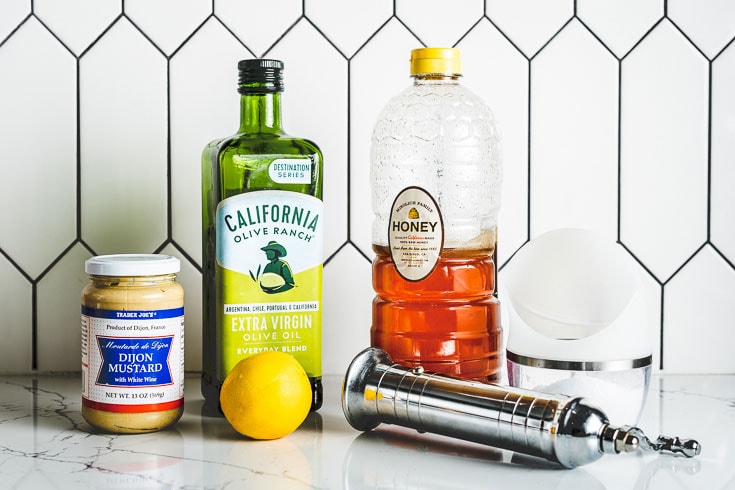
The Ingredients
- Lemons: We’re using the juice and the zest. I prefer the flavor of Meyer lemons, but any type will work great.
- Lemon zest: optional but adds even more lemon essence and essential oils from the lemon. I prefer to use the zest of organic lemons.
- Extra-virgin olive oil: Use a good quality oil and taste it before you use it. Since it makes up around half of the dressing, it has a big influence on the overall flavor.
- Honey, maple syrup or sugar: You have to have some sweet to balance out the acid. I love using local honey, but any type of sweetener will work.
- Dijon mustard: Adds some spice and helps create an emulsion between the oil and lemon juice.
- Chopped shallot: Slightly sweeter than regular onions and perfect for eating raw. They will even pickle slightly when added to the vinaigrette before the olive oil.
- Kosher salt and freshly ground black pepper.
- Optional add-ins: Minced garlic, fresh herbs such as thyme, chives or parsley. Make it a lemon-basil vinaigrette by adding some finely minced basil. Adding in chopped anchovies can make it taste a little like a healthy Caesar dressing.
Different Types of Lemons
There are two main types of lemons available at most grocery stores.
Standard lemons are generally larger with a more textured lighter yellow skin and are higher in acidity.
Meyer lemons are actually a hybrid between a standard (Eureka or Lisbon) lemon and a mandarin orange/pomelo hybrid, and are originally from China. They are much less acidic and have floral and some slightly sweet notes. The skin is much smoother. Read more about Meyer lemons from Specialty Produce.
Substituting different lemons in the vinaigrette: Both types of lemons work wonderfully in a vinaigrette, but their flavor and acidity is quite different. If you are using standard lemons, you will likely use less lemon juice and more sweetener to balance it out. Meyer lemons also don’t stand up as well to very strong peppery olive oils.
Just note that all lemons are different in terms of acidity and the amount of juice you will get. Adjust accordingly.
Top Tips for Success
- Roll the lemon with your hand before cutting and squeezing to extract all the juice.
- Find a nice neighbor who has a lemon tree and is willing to share. Homegrown lemons are the best and are free.
- Start with a ratio then adjust to your taste. Adjust the acidity and sweetness to your liking. Constantly test to see how different ratios of the ingredients affect the flavor on your palate. You can always add more lemon juice or olive oil to balance it out.
- Make enough dressing for the week so you can enjoy a delicious salad every night with no excuses.
Make It a Creamy Lemon Vinaigrette
Just blend the dressing with an immersion blender and it will naturally get completely emulsified and creamy. Be sure to taste it after it is pureed as the flavors can change.
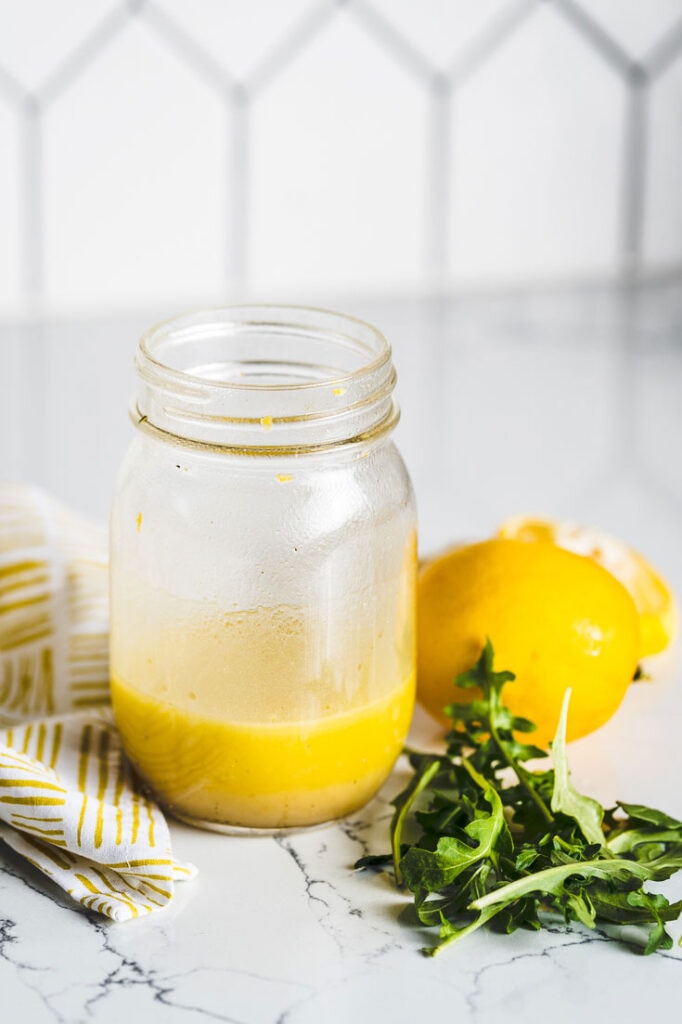
FAQs
Store the vinaigrette in the refrigerator sealed in an airtight container. This is one of the advantages of making it in a Mason jar.
Since there is fresh lemon juice, shallots and mustard, this vinaigrette needs to be refrigerated in a sealed container and will last up to 5 days.
If it turns out too tart for your taste, you can incorporate more oil or honey/sweetener to reduce the acid level.
Perfect on a baby arugula salad with Parmesan, a butter lettuce salad with avocado and citrus or a pasta salad; drizzled on roasted veggies, steamed asparagus, avocado toast; topping meats such as grilled swordfish or even beef for an Italian-style steak.
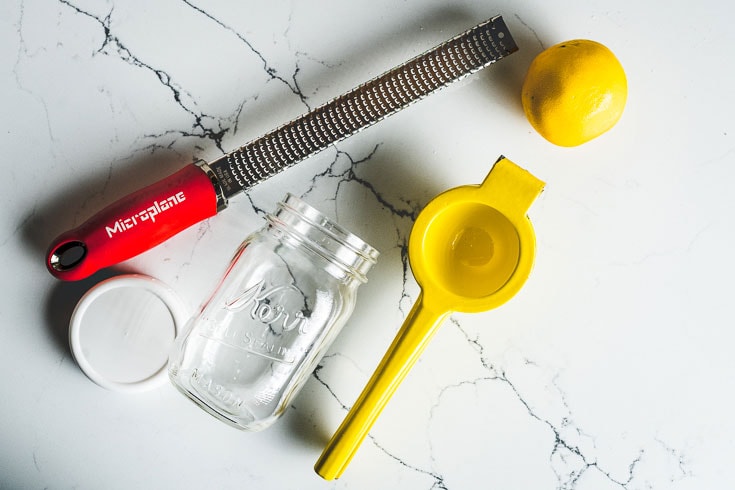
Tools and Equipment
While you can totally make a vinaigrette with whatever you already have in your kitchen, there are a few tools that make it even easier and more enjoyable.
- Lemon juicer
- Mason jars with lids or an OXO Good Grips Salad Dressing Shaker
- Microplane for zesting the lemon.
- Bowl and whisk (if using the bowl and whisk method)
- Salad spinner
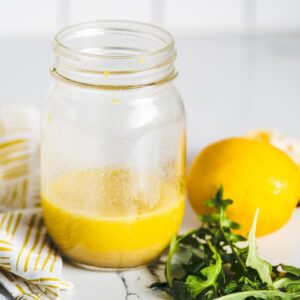
Lemon Vinaigrette
Ingredients
- 1/4 cup lemon juice
- 1/2 tsp. lemon zest
- 1 Tbsp. finely minced shallot
- 2 Tbsp. honey, maple syrup or sugar (more or less depending on the acid level of your lemon)
- 1/2 tsp. Dijon mustard
- 1/4 tsp. Diamond kosher salt
- 1/8 tsp. freshly ground black pepper
- 1/4 cup extra-virgin olive oil
Instructions
The Jar Shake Method
- Add all ingredients to a jar with a tight-fitting lid and shake vigorously for about 30 seconds or until the dressing is emulsified and the honey or sugar is completely dissolved.
- Taste test before using for acidity, sweetness and salt. Make adjustments as needed.
Bowl & Whisk Method
- Add all ingredients except the olive oil to a medium bowl. Whisk to combine and dissolve the honey.
- While continually whisking, very slowly drizzle the olive oil into the bowl to emulsify the vinaigrette.
- Taste test before using for acidity, sweetness and salt. Make adjustments as needed.
Notes
- The recipe makes about 1/2 cup and can easily be scaled up or down.
- Roll the lemon before using to extract all the juice.
- Taste, adjust, repeat.
- Meyer lemons are sweeter and less acidic so taste and adjust accordingly.
- This recipe uses a 1:1 ratio of lemon juice to olive oil, but more oil can be added if you prefer a different ratio.
- Store sealed in an airtight container in the refrigerator for up to 5 days. Bring to room temperature to allow the oil to liquify before serving.
- Shake or whisk again prior to serving.

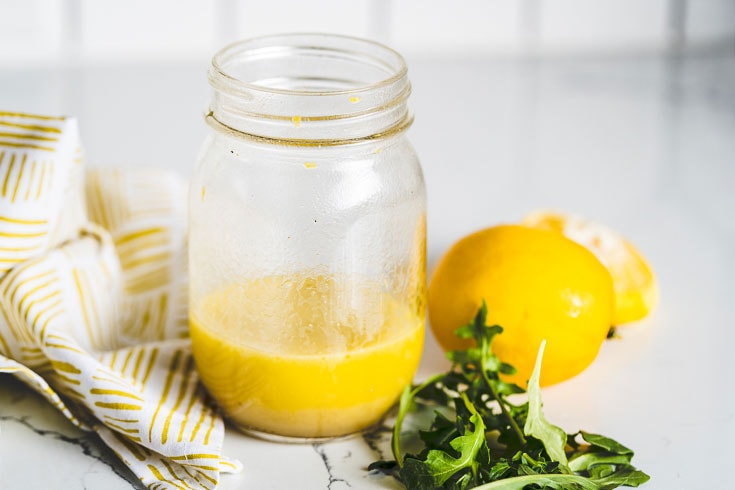


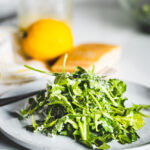

Made this last night and it is the perfect balance of acidic, sweet, salty, etc… love coming to your website for all the basics… I always know it’s going to be perfect!
How many calories and sodium in the vinaigrette ?
Thanks
Hi Gary. An estimate of 79 Calories and 77 mg of sodium per serving is what my system calculated.